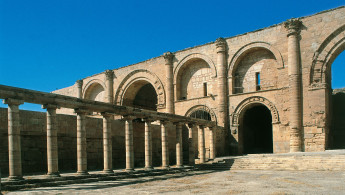Protecting world heritage from the new Vandals
UNESCO has launched the Global Unite for Heritage coalition to mobilise governments and heritage stakeholders against the intentional damage of cultural heritage, especially in the Middle East.
The UN agencies World Heritage Committee adopted the Bonn Declaration on World Heritage that condemns IS's assaults on cultural heritage in Iraq. This included the World Heritage site at Hatra where the group destroyed monuments in March 2015.
"The threat is global and our response must be global," said UNESCO Director-General Irina Bokova as she launched the initiative during the 39th session of the World Heritage Committee on 29 June 2015.
Bokova said the biggest problem was getting the relevant players to work together. They include the police, customs officials, museums, governments, and actors from the cultural, humanitarian and security sectors, civil society and the media.
The committee also expressed concerns for sites including Palmyra in Syria where IS has already destroyed ancient mausoleums and mined the ruins, and the Old Town of Sanaa in Yemen.
"The launch of this coalition marks a major step in our struggle against the destruction of cultural heritage in Iraq and in the rest of the world," said Adel Shershab, Iraqi minister of tourism and heritage who was present at the launch.
Beating IS digitally
| Remote monitoring is particularly useful in war-ravaged countries where on-the-ground surveys are dangerous. |
In a joint venture with Harvard University and the Classics Conclave, the Institute of Digital Archaeology plans to use 3D cameras to document cultural sites and relics lying in the militants' path.
A team led by archaeologist Roger Michel hopes to work with local partners to photograph as many items of historical interest as possible in case they are destroyed. He is relying on a patchwork of local museums, non-governmental organisations and volunteers to carry out the digital archiving.
"If we can get 5,000-to-10,000 [3D cameras] in the field in the next three or six months, then, if we can't protect these things at the ground, we can at least preserve a highly detailed record of what's there," he told the BBC.
The team faces challenges in the field due to the hot desert conditions, and patchy access to the internet and electricity. They will need strong cameras with a long battery life that can upload large files.
They have partnered with New York University's Institute for the Study of the Ancient World to store the 3D images, and Massachusetts Institute of Technology Three Dimensional Printing Laboratory to print them.
The Universities of Oxford and Leicester have also used satellite imagery and aerial photography as part of their project called Endangered Archaeology in the Middle East and North Africa.
The £1.2m project will create an open-access database, registering information about each site and its condition in easily accessible Geographic Information System format.
Remote monitoring is particularly useful in war-ravaged countries like Syria, Iraq, and Libya where on-the-ground surveys are dangerous.


![President Pezeshkian has denounced Israel's attacks on Lebanon [Getty]](/sites/default/files/styles/image_684x385/public/2173482924.jpeg?h=a5f2f23a&itok=q3evVtko)



 Follow the Middle East's top stories in English at The New Arab on Google News
Follow the Middle East's top stories in English at The New Arab on Google News


